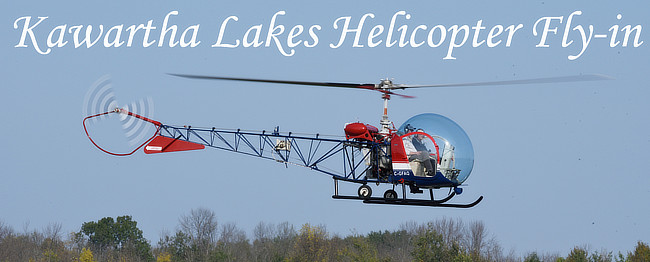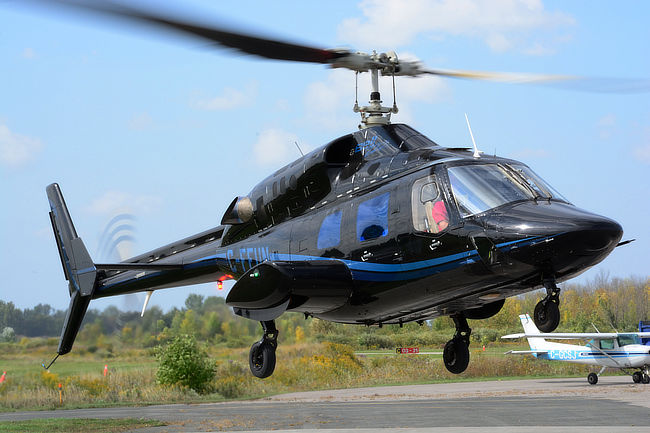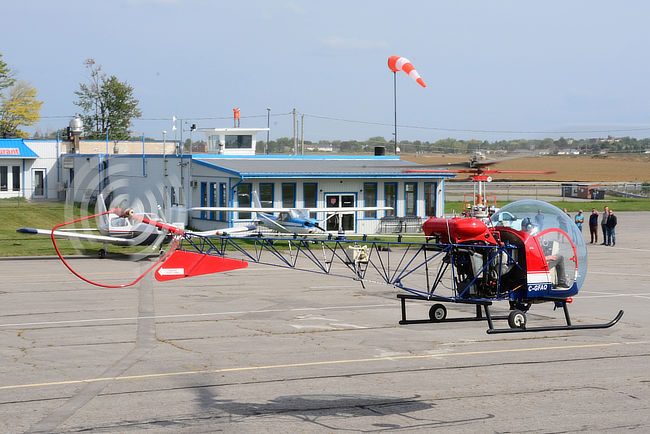ISSUE 840 - November 28, 2023 • Over 7,000 Total Ads Listed • 1,000+ NEW Ads Per Week
This eFlyer Has Been Sent To Over 151,000 Subscribers |
| Kawartha Lakes, Ontario Helicopter Fly-in |
| Kevin Moore, Contributing Writer & Photographer |
|
The first helicopter focused fly-in was held at Kawartha Lakes Airport in Lindsay, Ontario in mid September after the original date for the fly-in was rained out in August. Though 16 helos had originally registered only 9 made it to the event. Despite that, it was a successful event and the hope is to hold another in 2024 with more helicopters making it to the event.
|
|
| This is the first helicopter focused fly-in held in Ontario. |
|
|
| The Kiowa was utilised by the US and other militaries around the world. This particular helicopter is a former US Army chopper. |
|
The first helicopter to arrive was flown by event organiser, Manfred Harder, flying his former US Army OH-58A Kiowa. The Kiowa was originally designated as the D-250 as a LOH (Light Observation Helicopter) but lost out to the Hughes OH-6 Cayuse. Despite not being selected for the US Army, Bell continued to develop the aircraft and, in 1970, the OH-58D was selected by the US military and called the Kiowa Warrior. It was used in several roles including armed recon & fire support to friendly forces and was equipped with MMS (Mast Mounted Sight) which was used in laser designation and target acquisition. There were other developments as well that assisted in its use during the Vietnam War. The Kiowa was also used during the Gulf War and invasion of Panama, the Afghan War and in assisting with other conflicts and situations. They were replaced in 2017 after close to 40 years of service.
|
|
|
| The Bell 222 is a go places helicopter and you go in comfort in this baby! |
|
The largest helicopter to fly in was a Bell 222. Older folks may remember the television show, Airwolf, in which starred a modified version of the helicopter. The Bell 222 is a twin-engine helicopter developed in the late 1960s with its first flight in August of 1976. It was the first American designed light, twin-turbine helicopter to go to market. Manufacturing of the Bell 222 began in 1975 and were produced until 1991 with its upgraded version, the 230, produced until 1995. It was marketed as an executive helo and can be flown with a single pilot and seating for 6 to 10 people, depending on the variant. It is equipped with Noda Matic vibration reduction system, cabin heat & air conditioning and fully retractable landing gear, which gets tucked up into the aircraft sponsons. The Bell 222 is, arguably, one of the most luxuriously, sleek looking civilian helicopters around.
|
|
|
Change the colour to army green and you go back to the Korean War
and the hit TV series, M*A*S*H. |
|
The oldest helicopter at the fly-in was one M*A*S*H fans might recognise, the Bell 47. This 2 seat helicopter was a common sight in the tv show as well as in the Korean War. Designed & built by Bell Helicopter, it first flew in post-war US in December of 1945 and was the first helicopter introduced for the civilian market. They are single engine, single rotor aircraft with a "soap bubble" canopy, welded tube tail boom with saddle style fuel tanks and skid landing gear with some versions being fitted with 2 or 4 wheels. They were built with either the Lycoming or Franklin engine which was vertically mounted. Typically recognised as a 2 seat aircraft, later versions could seat 3 to 4. As a military aircraft it was designated as the H-13 Sioux and was used in several roles including search & rescue, medivac, scouting and reconnaissance.
|
|
|
| To many, the Schweizer name might invoke thoughts of gliders more than helicopter but Schweizer RSG builds a very popular machine. |
|
Probably the smallest helicopter that attended was a Schweizer 269C-1, a small 2-seat, single engine, 3 rotor blade aircraft originally developed by Hughes Helicopters in the mid 1950s with the first flight of the prototype in October 1956. It was built to fill the demand for a low-cost, two-seat, lightweight helicopter for the civilian market, utilised by police forces, in agriculture and other areas where an affordable, light helicopter was needed. The company was building roughly 20 a month into the early 1960s after capturing a large segment of the civil helicopter market. Further development of the 269 saw production of the 300 which was a slightly larger, 3-seat version. Eventually, production switched to Schweizer who began producing the 269 & 300 under license from Hughes Helicopter and eventually acquiring all rights to the aircraft. Schweizer was eventually purchased by Sikorsky Aircraft who eventually sold the product line to Schweizer RSG in Fort Worth, Texas.
|
|
|
| The A600 Talon has an insect look to it, especially in the bright green colouring. |
|
The most colourful of the visiting helicopters was the A600 Talon, showing similar lines to the Hughes 500. It is produced by RotorWay International in Arizona and comes in kit form for amateur building. The A600 is a side-by-side, 2-seat aircraft with a 147hp, four stroke, turbocharged engine and current builds are done with a MGL Avionics, all-glass instrument system. An interesting option is the luggage pod which is attached to the underside of the cockpit/fuselage. The airframe, tailboom, rotor system and engine all come from the manufacturer fully assembled and include aircraft blueprints, construction and maintenance manuals and templates. For anyone considering building & flying their own helicopter, the A600 might be for you.
|
|
|
| The Eurocopter AS350 Ecureuil (Squirrel) is a high tech, workhorse helicopter for many rather than a privately owned, family machine like this one. |
|
The AStar, or Eurocopter AS350, is from Airbus Helicopters and is a single engine aircraft originally designed & built by Aerospatial in France, then by Eurocopter, which is now Airbus Helicopters. It first flew in June of 1974 with introduction into the market in 1975. It was first produced as a cost effective & economical helicopter for the civilian market though it was further developed for use in both the civil and military markets. Over the years of production the aircraft has received upgrades and improvements including engines, avionics and new tail-rotor system. It is single pilot flown and has seating for up to 5 passengers. They are utilised by a multitude of militaries and governments around the world as well as in civilian operations, commercially and privately.
|
|
|
From the same family of Robinson helicopters is the R44 Raven I, left,
and the R66 Turbine, right. |
|
Robinson helicopters was well represented by both the R44 Raven and the R66 Turbine. These are very similar looking helicopters but with different performance numbers. The R44 is a 4-seat helicopter that was first developed by Robinson Helicopter Company in the early 1980s. The first flight of the R44 was in March 1990, eventually introduced to the market 3 years later. It has proven to be a very popular aircraft in the helicopter market. The R44 Raven came to market with hydraulically assisted flight controls as well as adjustable pedals. The R66 Turbine seats 5, is slightly faster than the R44 and is considered to have a smoother flight performance. It first flew in 2007 and went into full production in 2011. It burns more fuel than the R44 but will get you where you need to go a little further, a little faster and with a smoother ride.
|
|
|
| Two very different helos but from the same family, the Bell 47, left, and the Bell 222, right. |
|
Kawartha Lakes Municipal Airport (klma.ca) is located about a half mile from the city of Lindsay, Ontario. The city owns two T-hangars each housing 10 internal units and rental fees range from $375 - $475/month. There are also a number of privately owned hangars on the field. Aviation fuel (100LL & Jet-A) is available 24/7 through their self serve cardlock fueling system. You can obtain a discount in your fuel cost by applying for a pre-paid fuel account. Aircraft tiedowns are available for $35 - $65/month. Through the winter they also keep runway 31/13 cleared, normally done by 0900 the morning after a snowfall. Also available at the airport are sightseeing flights, flight training and an extremely popular restaurant called "Airportview Restaurant."
|
|
|
| The Enstrom 280 FX, hovertaxies, left, and prepares to depart the fly-in, right. |
|
The Enstrom Helicopter Corporation is an American helicopter manufacturer based in Michigan. The 280 FX was first introduced to the aviation market in 1965 with production running from 1965 to present. The 280 FX is one of 3 types of helicopters produced by Enstrom, including the 28 and the 480. There are 5 variants of the 280 with changes to the aircraft including a turbocharged engine, 4-seat version and more powerful engine options. They have been produced for both the civilian and military markets. By 2007 Enstrom had produced in excess of 1200 helicopters. Though the company has been through bankruptcy and sold into different hands, they continue to produce helicopters in their Michigan plant.
|
|
|
Two of the smallest helicopters to visit were the Schweizer 269C-1, left,
and the A600 Talon, right. |
|
The city of Lindsay has lots to offer and is an easy 10 minute walk from the airport. In and around the city you'll find a movie theatre, Kawartha Lakes Museum & Archives, Lindsay Gallery, Lindsay Memorial Park, two theatres, a nature centre, the Lindsay Square Mall and many summer and winter attractions. There are also a multitude of sit-down, family type restaurants, fast food restaurants, grocery stores, beer & liquor stores, gift shops, hardware stores, fuel stations, convenience stores and more as well as hotels, motels, B&Bs and camping in the area. Everything you would want or need is available and close enough to the airport, whether you walk to town or hail a cab.
|
|
|
| Departing at the end of the fly-in, the Aerostar, left, and the Kiowa, right. |
|
So, if you're flying in central, eastern Ontario a great place to stop is Kawartha Lakes Municipal Airport for fuel and a bite to eat, at the airport restaurant or in town. Keep an eye out on the COPA calendar for 2024 fly-ins, including the next Ontario Helicopter Fly-in. Make plans to fly, or drive, to some of the great fly-ins available throughout the country. If coming to KLMA, park the airplane for a few hours and head into town. Lindsay is a great place to visit. The airport folks are warm and welcoming and there may even be somebody around who can take you into town if you're not up for a walk.
|
|
|
| Two very different cockpit & instrument panels with the older Bell 47, left, and its basic looking panel, and the Bell 222 with a very busy looking panel, right. |
|
|
| Parked during the fly-in, the Robinson R44 Raven I, left, and the Kioawa, right. |
|
|
| Fueling up the Bell 47, left and parked during the fly-in, right. |
|
| The Bell 222 hovering in place after lifting off, ready to depart. |
|
| The Bell 47 hovertaxies past the Kawartha Lakes terminal & restaurant after filling up on some fuel before departing the airport. |
| By Kevin Moore, Contributing Writer & Photographer |
|
| |
|


































